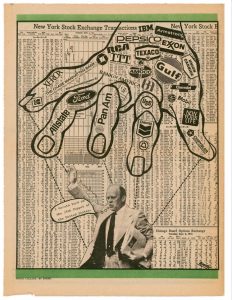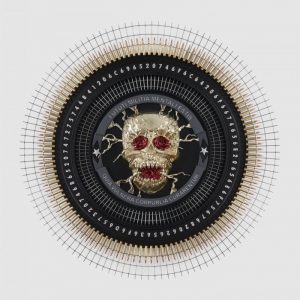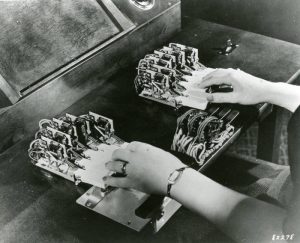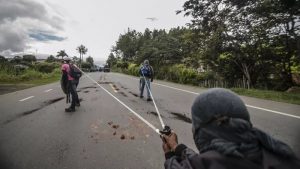Today, as part of The Bilderberg’s Future_Brunch 101 salon at Transmediale, Francis Hunger gave a presentation about The Setun Conspiracy which received an Honorary Mention last night at the Transmediale ceremony (details about the winning projects in this press release PDF.)
And for whatever this is worth, it was my favourite work among the nominees…
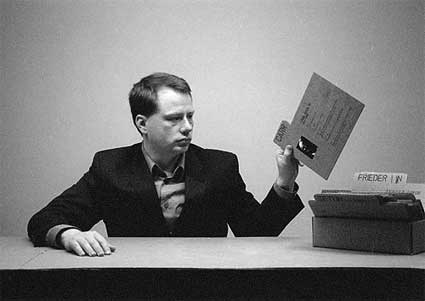
The SETUN computer was developed in 1958 by Nikolai Brusentsov and his team at the Moscow State University. SETUN is based on ternary logic (-1, 0, 1), which distinguishes it completely from the usually binary operating computers of the present and the past. While the binary logic just allows two states yes (1) | no (0), the ternary logic has three different logical states: yes (1) | no (-1) | both or maybe (0). Western computer scientists tried to create such a ternary computer in the following years but never succeeded.
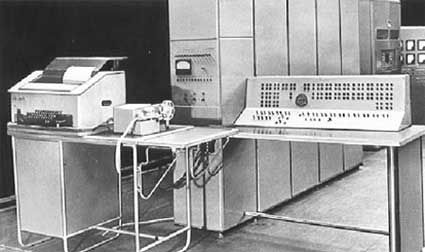 “Setun” trinary computer developed at Moscow University (image)
“Setun” trinary computer developed at Moscow University (image)
Francis Hunger’s work consists of several elements: the archive research collected since 2003, representation of the results in form of an office since 2005 and a book with essays and interviews, which is is just out from the printer*.
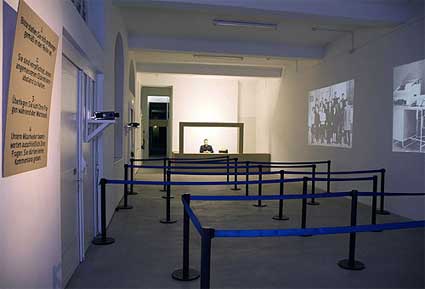 Installation view
Installation view
The installation puts visitor in an office situation with a waiting line of rope and stanchions that lead to a cardboard office, reminding the high security places where human behaviour gets directed. The waiting line are meant to have visitors experience the whole space, getting to watch 2 images projected on the wall (one of the computer, another one of the team who developed it) and read the list of rules that instructs their behaviour: people are allowed to ask questions only, not to make comments; they should access from the right side; they should keep a discretion distance since it is an individual session with only one or maximum two persons allowed to come near the performer at the time. Any visitor who would not respect the rules will be dismissed.
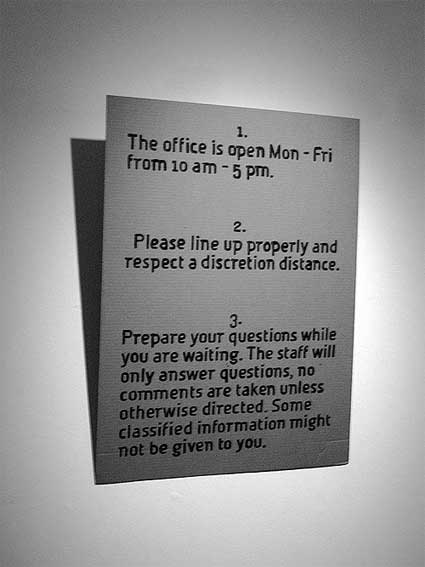
It is both a “discipline and punishment” situation but also a playful one.
After having done extensive research about Setun (exchanging emails with Nikolai Brusentsov, extensive readings and research for documents written about the computer, etc.), Francis’ concern was “What is the best way to distribute knowledge?” A text could of course transmit the knowledge but wouldn’t produce the same situation, that level of interactivity. Throughout the “interactive” performance Hunger is the only one who has the knowledge. If people ask the right questions they might discover whether the Setun conspiracy is a fact or a fiction.
Hunger than read a text that has influenced a lot his ideas about interactivity. It is a statement that Alexei Shulgin wrote11 years ago and which addresses the question of interactive art:
Looking at very popular media art form such as ‘interactive installation’ I always wonder how people (viewers) are excited about this new way of manipulation on them. It seems that manipulation is the only form of communication they know and can appreciate. They are happily following very few options given to them by artists: press left or right button, jump or sit. Their manipulators artists feel that and are using seduces of newest technologies (future now!) to involve people in their pseudo-interactive games obviously based on banal will for power. But what nice words you can hear around it: interaction, interface for self-expression, artificial intelligence, communication even. So, emergence of media art is characterised by transition from representation to manipulation.

The Setun was what was called at the time an “electronic calculation machine”. For Nikolai Brusentsov, the ternary system was the most logical solution. It also turned up that it allowed to build the machine using less units and it was much more reliable than other computers made at the time. 50 copies were manufactured which, again, was quite an achievement for the time. It was used for agricultural calculation, nuclear power plants, for teaching programming, etc.
Here’s some more info found on the Soviet Computing website: Unfortunately, after the Setun-70 project, Brusentsov’s lab was relocated from the Computer Center at Moscow University to a windowless attic in a student dormitory and was deprived of any serious support. The new university rector considered computer design a pseudo-science. Brusentsov’s original Setun computer, an experimental prototype that had faithfully worked for seventeen years, was barbarically destroyed and carted off to the dump. Brusentsov’s laboratory coworkers took the Setun-70 to their attic laboratory and used it as a basis for developing the Master Work Station – an educational computer system.
To this day, Brusentsov maintains that the trinary system is superior to binary.
The artist is actually not happy with the title of his work. The word conspiracy evokes two ideas, it also evokes the difference between telling History and telling a story. There are conspiracies that exists. For example, the conspiracy against President Allende in 73 which is now sustained by well-recognized facts and sources which can be named. And then there is conspiracy that supports ideologies and simplifies world views. In the performance, the word “conspiracy” is used to get people interested in the work.
One year before Setun, on October 4, 1957 Sputnik satellite went up which triggered the “Sputnik Shock” in the US. They suddenly getting interested and preoccupied by this success of Russian technology. The conspiracy that Hunger constructed was that the Russians didn’t want to show the Setun computer but the US tracked down and found a traitor ready to talk to them about the computer.
More info about the book:
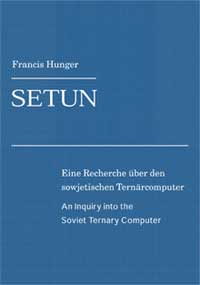 *SETUN. An Inquiry into the Soviet Ternary Computer. Eine Recherche über den Sowjetischen Ternärcomputer. Institut für Buchkunst Leipzig. German/ Englisch, ISBN 3-932865-48-0
*SETUN. An Inquiry into the Soviet Ternary Computer. Eine Recherche über den Sowjetischen Ternärcomputer. Institut für Buchkunst Leipzig. German/ Englisch, ISBN 3-932865-48-0
The work deals with the production and representation of knowledge, the historical and ideological aspects of technological development, and it aims to create an understanding of the intertwining of current technological and social developments using a historical perspective. The book makes original Russian sources available in English and German language and is accompanied by an original essay investigating into the relations between the “communist” Easts’ and capitalist Wests’ technological development. While the book aimes to provide a basis for further research, the artistic work tries to involve visitor and artist into what can not be expressed within the realm of theoretical discourse.

